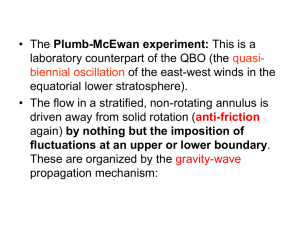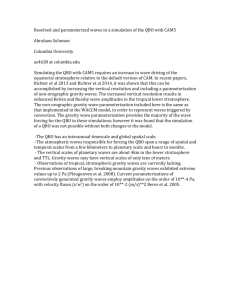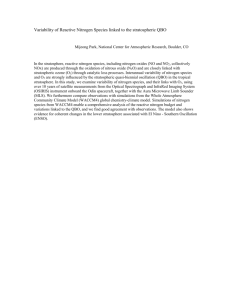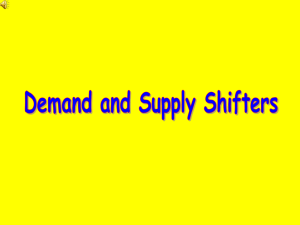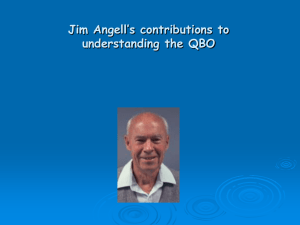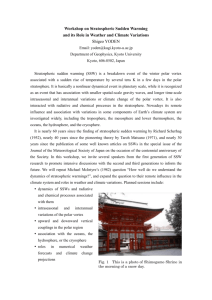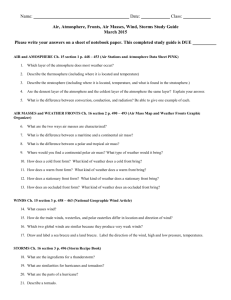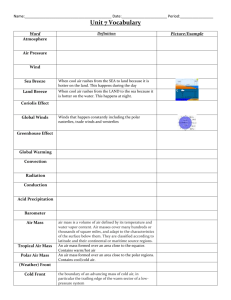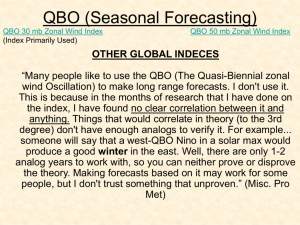Why is the QBO important?
advertisement
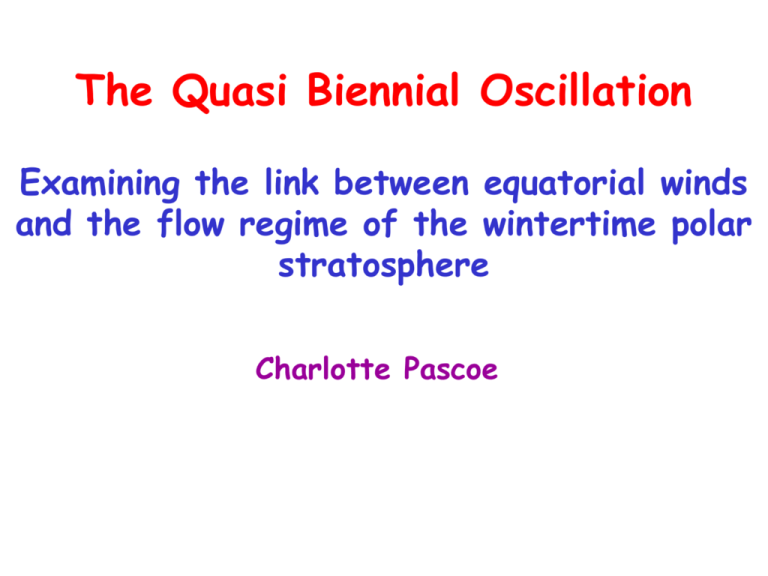
The Quasi Biennial Oscillation Examining the link between equatorial winds and the flow regime of the wintertime polar stratosphere Charlotte Pascoe Layout of Talk Introduction QBO history How does the QBO work? Why is the QBO important? Polar vortex and planetary waves The Unified Model • Experiments • Results Summary QBO History 1883 Krakatau debris circles the globe from east to west in two weeks: Krakatau Easterlies 1908 Berson launches balloons from Lake Victoria in Africa and finds lower stratospheric winds blowing from west to east: Berson’s Westerlies QBO History 1960 Reed (US) and Elbon (UK) “The circulation of the stratosphere” Balloon measurements reveal alternate bands of easterly and westerly winds originating above 30km and moving downwards through the stratosphere at ~1km per month. Bands appear at 13 month intervals 26 months required for a complete cycle QBO History 1960s Lots of meteorologists get sun tans whilst releasing balloons to measure this strange new phenomenon. All find slightly different cycle periods. 1964 Angell and Korshover give the cycle the name: Quasi Biennial Oscillation The Quasi Biennial Oscillation 60 km 40 m/s height -40 m/s 20 km 30 m/s -30 m/s 1965 QBO phase denotes wind direction in the lower stratosphere time 1987 top panel: equatorial zonal winds from rocketsonde middle panel: de-seasonalised bottom panel: broad-band filtered (18-36 month) How does the QBO work? Holton and Lindzen (1972) proposed a model of the QBO based on vertically propagating waves. The mechanism was further explained by Plumb (1977). Equatorially trapped Kelvin waves provide westerly momentum and Rossby-gravity waves provide easterly momentum to produce the QBO oscillation. Wavy blue and red lines indicate the penetration of easterly and westerly waves Why is the QBO important? Hurricane Forecasts West: Increased activity in the Atlantic and NW Pacific East: Increased activity in the SW Indian basin Stratospheric Winter Warmers Holton and Tan (1980) West: Cold undisturbed polar vortex More stratospheric Ozone loss East: Warm disturbed polar vortex More tropospheric `cold snaps’ Example of a Stratospheric Sudden Warming PV on the 1250K isentropic surface (~42 km) Planetary wave of wave number one Vertical propagation of planetary waves Planetary waves (aka Rossby waves) drift to the west relative to the background flow at typical speeds of a few metres per second. The vertical propagation of planetary waves is only possible under the condition that the zonal wind is within the range: 0<u<B/(k2 + l2) Under conditions of easterly background flow no vertical propagation of planetary waves can occur. (Westerly flow is never strong enough for the upper limit to be reached) Charney and Drazin (1961) found no stratospheric planetary waves in summer when the background flow is easterly. QBO as wave guide The QBO phase determines the position of the zero-line in the subtropics which acts as a critical line for planetary waves propagating into the stratosphere. QBO EAST Critical line is in northern subtropics QBO WEST Critical line is in southern subtropics Planetary waves are free to move into the Southern Hemisphere Planetary wave activity is confined to high northern latitudes Increased heat and momentum transport into the polar vortex region Less wave activity close to the pole WEAK POLAR VORTEX STRONG POLAR VORTEX However… The Holton-Tan relationship is not exact, there are many exceptions to this rule of thumb. Gray, Drysdale, Dunkerton and Lawrence (2001) have suggested that equatorial winds in the stratopause region are also important and may help understand polar vortex variability. J-F Polar temperature North of 62.5oN at 24km correlated with equatorial winds Holton-Tan Negative correlation between polar temperature and equatorial winds Significant correlation in stratopause region where QBO and SAO interfere Model Description • • • • • • • • UKMO Unified Model (version 4.5) Hydrostatic primitive-equation model Run in atmosphere only mode 64 vertical levels: 1000-0.01 hPa (0-80 km) X-direction (E-W): 96 columns (3.75o) Y-direction (N-S): 73 rows (2.5o) Rayleigh friction imposed above 50 km Ocean climatology repeated each year Experiments 3 QBO profiles (period 27 months) 1 SAO profile (period 6 months) QBO Thick: Large overlap with SAO QBO Thin: No overlap with SAO QBO Normal: Moderate overlap with SAO Algorithm U=U–timestep/rlxtime(U-(UQBO+USAO)) Experiments QBO and SAO forcing amplitudes wrt height and latitude QBO + SAO amplitude functions 70 60 Latitude dependence 1.2 1 40 magnitude Height (km) 50 30 20 10 0.8 0.6 0.4 0.2 0 0 0 5 10 15 20 25 30 Magnitude (m/s) 35 40 -60 -50 -40 -30 -20 -10 0 10 latitude 20 30 40 50 60 Experiments Relaxation time scale wrt height and latitude Latitude Dependence Relaxation Time Scale 10000 70 y 1000 60 100 10 50 -50 -40 -30 -20 -10 0 10 20 30 40 50 60 40 50 60 latitude 40 Latitude Dependence 30 300 250 20 200 y height (km) 1 -60 10 150 100 50 0 0 2 4 tim e (days) 6 8 0 -60 -50 -40 -30 -20 -10 0 latitude 10 20 30 Results SAO QBO Results 40hPa Equatorial wind & 10hPa Polar temperature WEST EAST Results January and February zonal wind composites Results J-F Polar temperature North of 60oN at 10hPa (~30km@70oN) correlated with equatorial winds Positive correlation in upper stratosphere Negative correlation in lower stratosphere Summary • Need to run the simulation for longer • We are finding the expected negative correlation between lower stratospheric equatorial winds and polar temperatures • There is also a positive correlation in the upper stratosphere • No asymmetry about the mid summer months (June and July) but this should be fixed by including an annual cycle over the equator
